Osaka Honganji Temple: The Jodo Shinshu sect of Buddhism was divided into East and West
The Higashi (east) and Nishi (west) Honqanji Temples stand along Shichijo Street in Kyoto, less than 500 meters away. The Goei-do of the Higashi Honganji is the largest wooden founder hall in the world and enshrines the wooden statue of the founder, Shinran. The Nishi Honganji, a World Heritage Site, has remained intact to this day despite several fires during the Edo period. Its Amida Main Hall, Goeido Hall, Hiunkaku, and Karamon Gate (all national treasures) preserve the splendor of the Momoyama culture. Have you ever wondered about the background of the fragmentation of Honganji into East and West? Let’s explore its history, shaped by the tumultuous period.
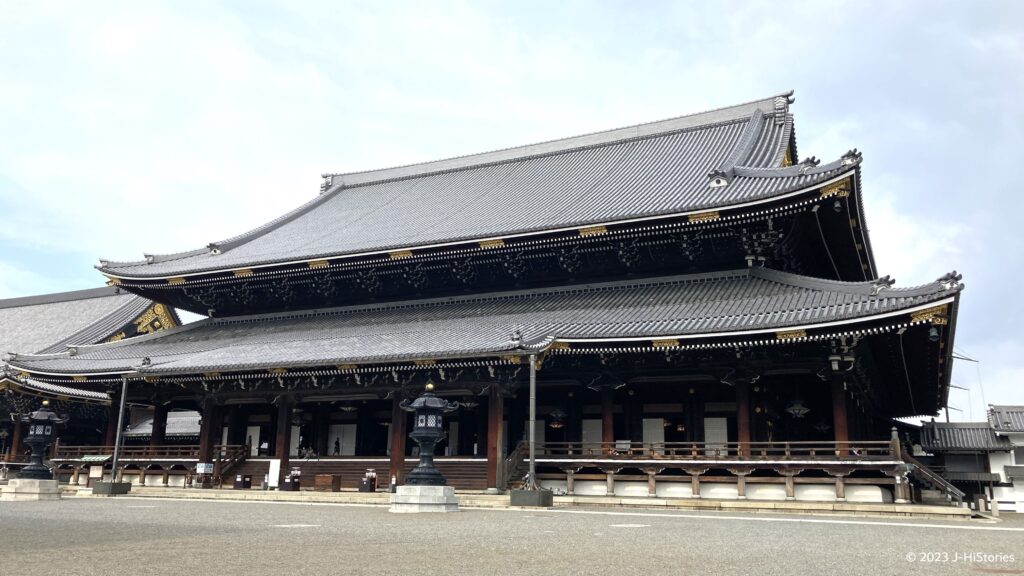
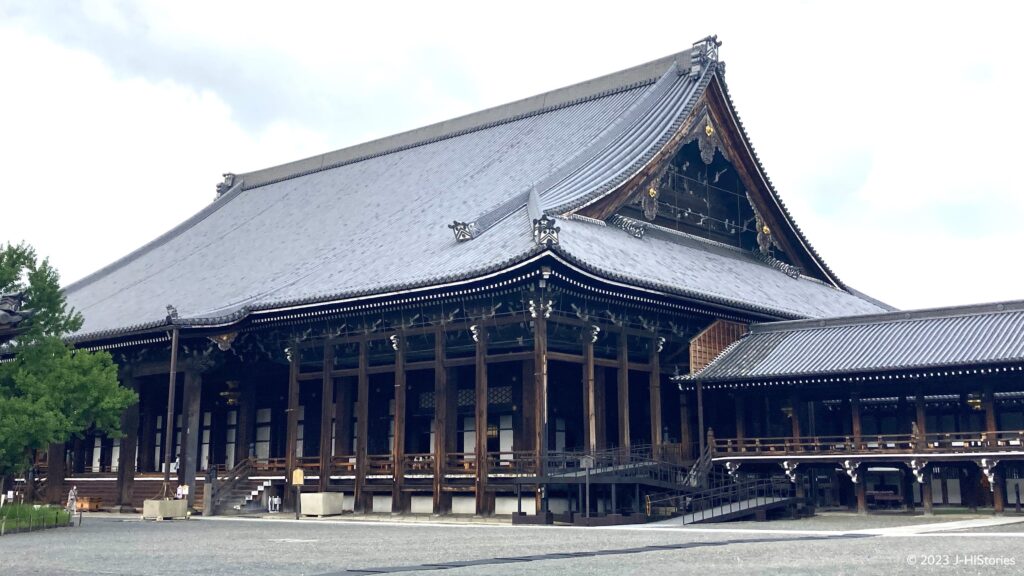
Honganji Became Embroiled by Three Powerful Samurais

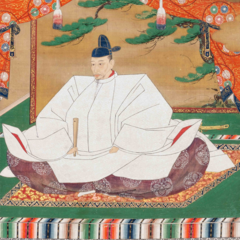
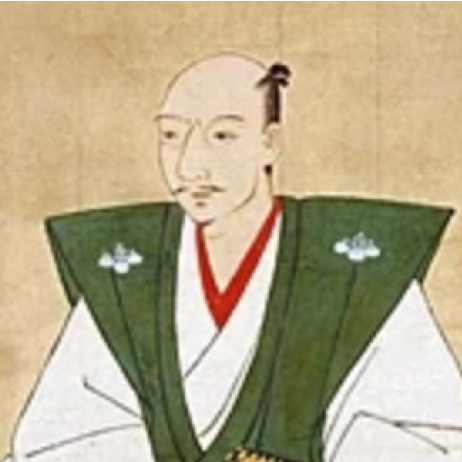
During the end of the Warring States period (15th to 16th century), Honganji, the largest Jodo Shinshu sect of Buddhism, was affected by the three warlords: (1) Oda Nobunaga (1534-1582, 織田信長), who emerged as a possible unifier of the country among many warlords, (2) Toyotomi Hideyoshi (1537-1598, 豊臣秀吉), who succeeded Nobunaga, and (3) Tokugawa Ieyasu (1542-1616, 徳川家康), who ended the Warring States period and established peace in the nation. Due to these circumstances, Honganji became embroiled in the wars, eventually resulting in its division into East and West.
Honganji Flourished at Ishiyama
Osaka Honganji, also known as Ishiyama Honganji, was located on the edge of the Uemachi Plateau facing Osaka Bay and was an important traffic point. Rennyo - the 8th Hossu (the head) of Honganji, revived and promoted the decaying Jodo Shinshu and discovered Ishiyama to be suitable for a "Buddhist land". It grew into a large temple town where 40,000 people, including craftsmen, merchants, and transporters, lived with various privileges, such as free trade, tax exemptions, and "Funyuken" ((the right to refusal of entry of external affairs). Therefore, it accumulated enormous wealth by trading with other areas.
"Move out from Ishiyama", Nobunaga's Unacceptable Demand
The most powerful Samurai, Nobunaga, aimed to unify Japan by defeating the powerful feudal lords one after another and wanted to control the transportation hub. As a result, he demanded that Honganji leave Ishiyama. The Hossu, Kennyo (1543-1592, 顕如), repeatedly pleaded to drop Nobunaga's request to protect the Buddhist land but failed. After several failed negotiations, Kennyo finally ordered an uprising by his followers in various regions in September 1570, thus beginning the nearly 10-year-long Ishiyama War. Osaka Honganji Temple was a solidly defended temple town surrounded by earthen mounds, fences, and moats as if it was the "Ishiyama Castle". Kennyo’s eldest son Kyonyo (1558-1614, 教如), was one of the central figures to split Honganji into the East and West and was 13 years old at the time.
The Beginning of the 10-year Ishiyama War
According to Kennyo's order, Honganji followers in Ise Nagashima (Mie prefecture) attacked Koike Castle defended by Nobunaga's brother and drove him to suicide in the castle tower in only six days. The battle revealed to Nobunaga the fear of the Honganji forces, who were mainly farmers. In May of the following year, Ise Nagashima’s followers successfully defended against Nobunaga’s fierce attack. The battle between Honganji and Nobunaga continued here and there, like a local war. Kennyo initiated a strategic approach to win. In February 1573, Kennyo set up anti-Nobunaga camps simultaneously in various parts of the country: Omi (Shiga), Mikawa and Owari (Aichi), and Mino (Gifu). He also formed alliances with the Shogun of Muromachi Shogunate, Ashikaga Yoshiaki, and warring feudal lords who were anti-Nobunaga, such as Takeda Shingen, the Asai, and Asakura clans. Finally, the powerful warlord Shingen started marching toward Kyoto and defeated Nobunaga's allied Ieyasu army at Mikatagahara, putting Nobunaga in mortal danger. However, the guardian deity was on Nobunaga's side because Shingen died of illness on his way to Kyoto. Taking advantage of this opportunity, Nobunaga banished Shogun Yoshiaki from Kyoto, destroyed the Asai and Asakura clans, and concentrated on fighting the Osaka Honganji temple. Facing this situation, Kennyo made peace with Nobunaga in 1573. However, two months later, he again rose with another anti-Nobunaga warring lord, the neighboring Miyoshi clan. At the same time, Honganji followers in Echizen (Niigata prefecture) rose as well. The battle between Honganji followers in Nagashima and Echizen and Nobunaga ended in Nobunaga's victory, and Kennyo made peace with Nobunaga again.
Expanded to Naval Battles, Honganji won but Lost the Next
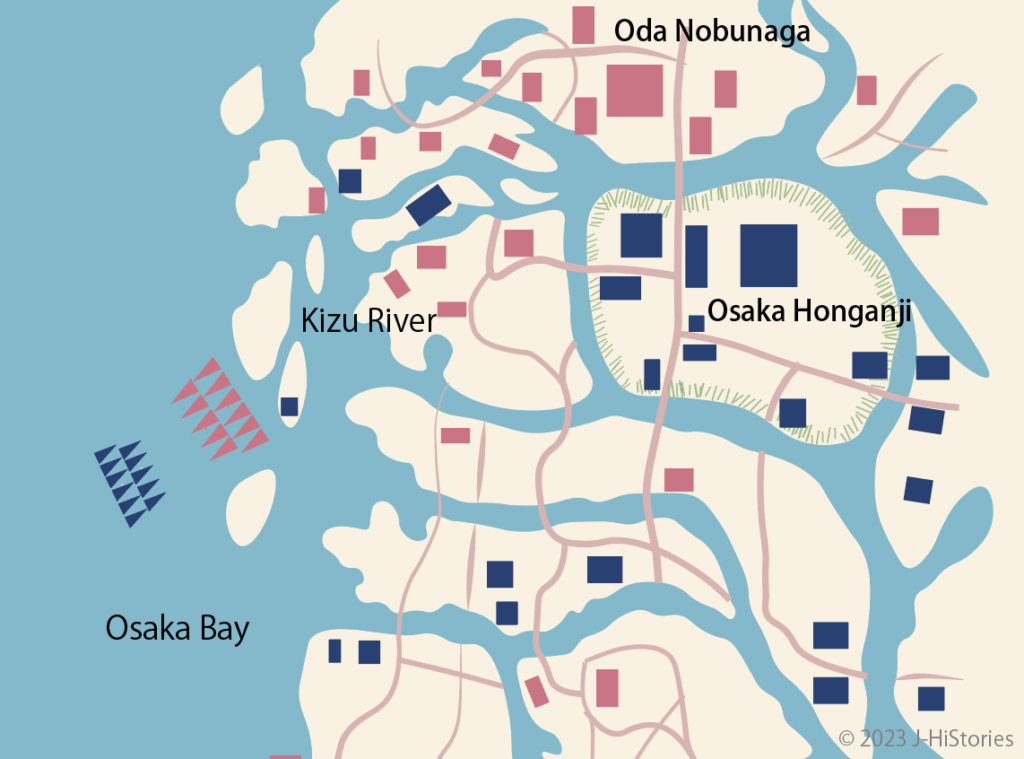
In May 1576, Nobunaga constructed 10 outlying castles surrounding the Osaka Honganji Temple town and blockaded the sea routes to prevent the delivery of food and weapons. The town was completely blocked, and the battle eventually moved to the temple itself. However, Kennyo did not give up and sought the help of another anti-Nobunaga warlord in the western region, the Mori clan. The Mori navy and their Murakami pirate allies, who controlled the Seto Inland Sea, launched a fierce naval battle at the Kizu River mouth, which was Honganji’s supply route. The Mori naval forces skillfully managed their ships to avoid being hit by guns and cannons. Conversely, they set Nobunaga's ships ablaze with their "horokuhiya" fire arrows. As a result, they successfully delivered food and weapons to the besieged temple, which allowed the temple to barricade itself inside and fight for an astonishing five years. Nobunaga learned from his mistakes and developed a breakthrough ironclad ship that could withstand the "Horokuhiya". In 1578, Nobunaga defeated the Mori navy with these iron ships, resulting in a severe food shortage for the Honganji. The temple was left completely isolated as all sea transport routes were cut off.
Finally, Emperor Stepped in to Intercede
At this point, the 106th Emperor Ogimachi (1517-1593, 正親町天皇), ordered both sides to make a peace agreement. Kennyo made the difficult decision to accept Nobunaga’s request for the evacuation of Honganji from Ishiyama and left Osaka Honganji Temple in April of the following year. Here, the 10-year-long Ishiyama War came to an end. However, Kyonyo (Age 23) and his followers opposed the retreat and decided to stay and fight in the temple despite his father's opposition. He sent letters to his followers in various countries, urging them to rise again. However, he was ultimately forced to leave the temple under the "imperial order of peace". On the night that Kyonyo left, August 2, 1580, a fire broke out and burned the entire temple and its town to the ground.
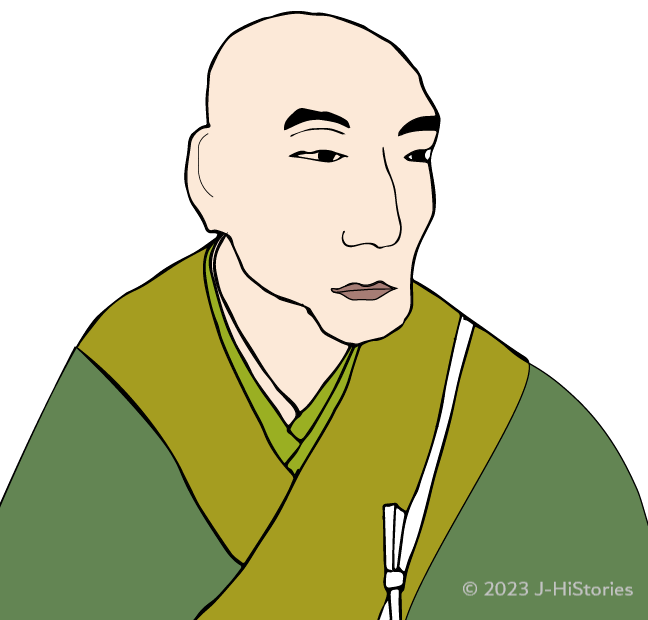
Disappointed, Kyonyo headed for Saginomori where his father lived. However, he was not allowed to enter Saginomori Honganji Temple because he had been disowned by his father. As a result, he wandered through the mountainous regions of Mino, Owari, and Mikawa. Once he heard about Nobunaga’s sudden death at the Honnoji incident in 1582, he went to Saginomori and reconciled with his father. After that, he and his father dealt with Hideyoshi's tough requests including the relocation of Honganji Temple twice from Saginomori to Tenma in Osaka and Kyoto (the current site of Nishi Honganji Temple) in 1591. The following year, in 1592, Kennyo passed away and Kyonyo took over as the Hossu (head priest) of the temple. Kyonyo implemented organizational reforms and promoted those who supported him during his difficult times resulting in the ousting of the anti-Kyonyo faction from power. However, Kyonyo's mother dissented from his assignment as the Hossu and showed Hideyoshi a document stating that her third son, Junnyo (1577-1631,准如), was Kennyo's successor. Her approach to Hideyoshi, the powerful man of the time, allowed an outside power to intervene for the first time in Honganji history regarding the succession of the head of the temple. Honganji also allowed the first land inspection of its temple town, which resulted in the loss of its free economy and autonomy. From Hideyoshi's point of view, he succeeded in weakening Honganji's ruling structure and strengthening the unification of the entire country.
Kyono's will to continue the fight promoted a feud between father and son

Kyonyo stepped down from his position but he continued to lead and guide his followers as if he was the Hossu. In 1598, following the deaths of his mother and Hideyoshi, Kyonyo began to seek the support of Tokugawa Ieyasu and met with him several times, believing that Ieyasu was destined to become the next powerful figure. A few months later, when Ieyasu emerged victorious in the Battle of Sekigahara against the Toyotomi faction, he donated the Karasuma area in Kyoto to Kyonyo, where Higashi Honganji Temple was established. In 1602, with Ieyasu’s support, Kyonyo obtained a venerable wooden statue from Myoanji Temple in Gunma prefecture, which is said to have been made by Shinran himself(*). This statue was essential in the establishment of the Higashi Honganji Temple. The original wooden statue enshrined at Osaka Honganji Temple was brought to Saginomori Honganji Temple by Kennyo when he left Ishiyama and is still enshrined at Nishi Honganji Temple. The bond between Higashi Honganji and the Tokugawa family continued until the end of the Edo period (1603-1868).
(*) (Reference: "Guide book of Kanto related to Shinran Shonin"; 親鸞聖人 関東ご旧跡ガイド by Honganji Publisher).
Honganji Temple,Divided into East and West
Why did Kyonyo establish the Higashi Honganji differentially? There are several theories regarding this matter. Due to the continuous interventions of Nobunaga and Hideyoshi, temples could no longer be free from the control of their rulers. Kyonyo approached Ieyasu, who was destined to become the next ruler of Japan, and decided to establish his own Honganji (later, known as Higashi Honganji) at Karasuma in Kyoto, which was donated by Ieyasu. It seemed to be his pride to continue the teachings of Shinran as the eldest son of Kennyo, rather than returning to the head of the Honganji (later Nishi Honganji), which had been solidly anti-Kyonyo. On the other hand, Ieyasu was on the way to consolidating power despite his victory at the Battle of Sekigahara because Hideyoshi's heir, Hideyori, was still alive at Osaka Castle, and several warlords of the Toyotomi clan were not in favor of the Tokugawa yet. Under such circumstances, Ieyasu followed Hideyoshi's decision to confirm the position of Junnyo as the head of Honganji. Instead, he gave Kyonyo a supportive push for his establishment of Honganji individually, according to the suggestion by Ieyasu’s vassal that the Honganji had already been divided into two. Furthermore, it is said that Ieyasu aimed to reduce the power of the largest Jodo Shinshu sect, Honganji, by splitting it into two, to smoothly rule over the whole country. Therefore, it was the result of the mutual interest of both Kyonyo and Ieyasu. (Reference: Kusano Kenshi, professor at Otani University, J-GLOBAL ID:200901074904508197).
A Father Tried to Protect Honganji by Leaving Ishiyama, and a Son Tried to Do by Defending Ishiyama
In the end, the feud between the father and son resulted in the division of Honganji into East and West due to Nobunaga's unacceptable request. However, it was evident that both aimed to preserve the Honganji, albeit through different means. Kennyo left Ishiyama, stating that as a Monzeki Temple (a temple with the head priest traditionally being a member of the Imperial or Regent Family), Honganji should follow the emperor's wishes. On the other hand, Kyonyo could not hand over Ishiyama, which houses the founder, Shinran's wooden statue, to Honganji's enemy, Nobunaga. He believed that Nobunaga would break a peace agreement and re-attack, based on his experiences of the reality in the Warring Age.
Passed on Shinran's Teachings to the Present-day
While visiting the two Honganji Temples in Kyoto, take a moment to reflect on the turbulent lives of Rennnyo, Kyonyo, and Junnyo as they fought against the powerful feudal warlords, Nobunaga, Hideyoshi, and Ieyasu. Despite facing numerous challenges, they succeeded in passing on the teachings of Shinran to the present day without faltering. In 2023, the Dharma service was held at both Honganji Temples in Spring. We invite you to join and recite its chant; “Namu Amidabutsu”.
Honganji Timeline
| 1497 | Rennyo built head temple of Honganji School at Ishiyama | Muromachi Period Warring States of Period |
| 1499 | Rennyo passed away at the age of 85 | |
| 1554 | Kennyo became the 12th hossu or head priest | |
| 1570 | Ishiyama War started | |
| 1574 | Honganji followers in Ise Nagasima were destroyed by Nobunaga | |
| 1575 | Honganji followers in Ecizen were destroyed by Nobunaga | |
| 1575 | Kennyo made a peace agreement with Nobunaga | |
| 1576 | Honganji won at the 1st battle of the Kizugawa River | |
| 1577 | Jyunnyo was born | |
| 1578 | Honganji lost at the 2nd battle of the Kizugawa River | |
| 1580 | Kennyo made a peace agreement with Nobunaga | |
| 1580 | Kennyo left Ishiyama. Kyōnyo barricaded himself in Ishiyama | |
| 1580 | Kyonyo left Ishiyama. Honganji Temple burnt down to the ground. | |
| 1582 | Nobunaga died at Honnoji incident | |
| 1582 | Kyonyo came to a settlement with Kennyo | |
| 1591 | Honganji moved to Kyoto | |
| 1592 | Kennyo passed away. Kyōnyo took over father's position | |
| 1593 | Kyonyo granted his positoin to Jyunnyo according to Hideyoshi's order | |
| 1600 | Kyonyo approached to Tokugawa Ieyasu. |
|
| 1600 | Battle of Sekigahara. Ieyasu won against Toyotomi clan | |
| 1602 | Kyonyo established Higahi Honganji at Karasuma, donated by Ieyasu | |
| 1603 | Kyonyo got Shinran's wooden statue | |
| 1603 | Kyonyo built Amida Hall | |
| 1603 | Ieyasu established Tokugawa Shogunate in Edo | Edo Peiod |
| 1614 | Kyonyo passed away at the age of 57 |
Recommendations to visit
Higashi Honganji Temple
- Access: A seven-minute walk from Kyoto Station
Nishi Honganji Temple
Access: 1 hour from Kyoto Station. Take bus #9 bound for "Nishigamo Shako-mae(西賀茂車庫)” at B1 or bus #28 bound for "Daikakuji (大覚寺)" at C6. Get off at "Nishi Honganji-mae(西本願寺前)" bus stop
Estimated site of Osaka Honganji Temple ruins in Osaka Castle Park
- Access: 10 minutes from JR Osaka Station on JR Osaka Loop Line (outbound) to Osakajo-koen Station (大阪城公園), then an 18-minute walk.
Recommended Itinerary
A Journey through the History of Jodo Shinshu Sect of Buddhism
Shinran entered the priesthood of Buddhism at Shorenin Temple, followed the teachings of his teacher Honen, and established and developed the Jodo Shinshu sect as a form of "salvation Buddhism", in which one could attain salvation by reciting "Namu Amitabha Buddha". After Shinran's death, the Jodo Shinshu sect started to decline, but Rennyo, the 8th head priest, revived it at Yoshizaki Temple in Fukui, which was located far from Kyoto. In his later years, Rennyo constructed the Osaka Honganji Temple. The 11th head priest, Kennyo, and his two sons fought a 10-year battle against Oda Nobunaga, the most powerful warlord of the time, because of its strategic location for transportation. Ultimately, through the intervention of the Emperor, they made peace with Nobunaga and surrendered the land of Osaka to him. However, Kennyo's eldest son, Kyoyo, wanted to continue the fight, leading to the division of the Honganji into Higashi (east) and Nishi (west) Honganji Temples, which still exist today. The Nishi Honganji Temple, supported by Toyotomi Hideyoshi, is home to many of his remains, including the Karamon Gate and the Hiunkaku Pavilion, National Treasures. Meanwhile, the East Honganji Temple was supported by successive Tokugawa shoguns, starting with Tokugawa Ieyasu. Tokugawa's prestige can be felt most clearly in the restored Honmaru Goten of Nagoya Castle and in the golden sliding door paintings of the Kano school.
Route Map
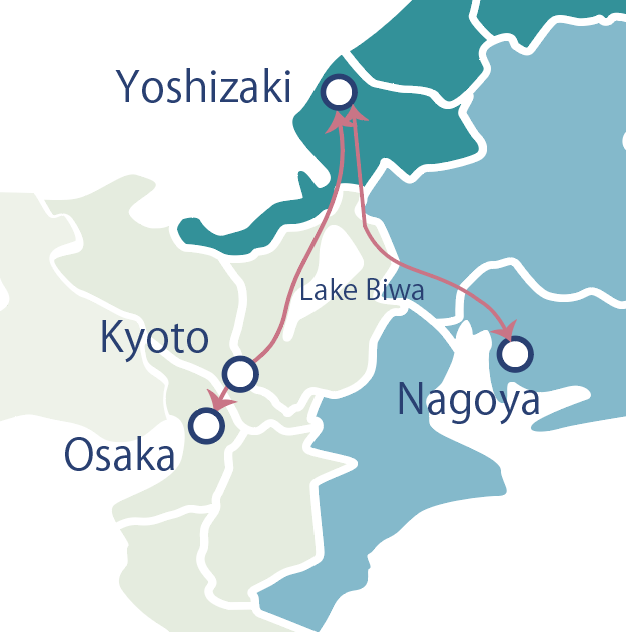
Exploring the history of Jodo Shinshu, this itinerary includes visits to the ruins of Osaka Honganji Temple, Shorenin Temple, and both Higashi and Nishi Honganji Temples in Kyoto, Yoshizaki Temple in Fukui, Nagoya Castle - a symbol of Tokugawa prestige, and Osaka Castle - a symbol of the Toyotomi.
Note: Visitors can enjoy one or two locations of the recommended three locations.
Best of Honganji Temples
Day 1: Osaka - Kyoto
- Osaka Honganji Ruin in Osaka
- Osaka Castle - Toyotomi Hideyoshi's castle
- Higashi Honganji Temple in Kyoto
- Nishi Honganji Temple in Kyoto
- Shorenin Temple in Kyoto
JR Train / Cycling along Lake Biwa (option)
Day 2: Fukui
- Yoshizaki Temple
- Awara hot spring (option)
JR Train / Cycling along Lake Biwa (option)
Day 3: Nagoya
- Nagoya Higashi sub-Temple
- Nagoya Castle - Tokugawa Shogunate's castle


